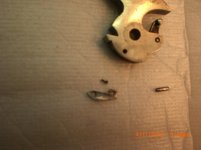Anybody know who might have a supply of old Smith & Wesson top break parts?
I have a .38 S&W Double Action Third Model that has a small component pinned in the hammer called a "fly." In this "fly" is a small leaf spring that is designed (I assume) to exert some kind of pressure on this particular part, but for what reason I don't know, as the gun functions perfectly without the fly doing anything. (??????????)
What I need is a source for parts for this gun, or, if somebody has an illustration of what the spring in the fly looks like, I can possibly fabricate one.
Numrich has a parts diagram of this revolver, but it shows only the fly and not the spring.
All help greatly appreciated.
I have a .38 S&W Double Action Third Model that has a small component pinned in the hammer called a "fly." In this "fly" is a small leaf spring that is designed (I assume) to exert some kind of pressure on this particular part, but for what reason I don't know, as the gun functions perfectly without the fly doing anything. (??????????)
What I need is a source for parts for this gun, or, if somebody has an illustration of what the spring in the fly looks like, I can possibly fabricate one.
Numrich has a parts diagram of this revolver, but it shows only the fly and not the spring.
All help greatly appreciated.

